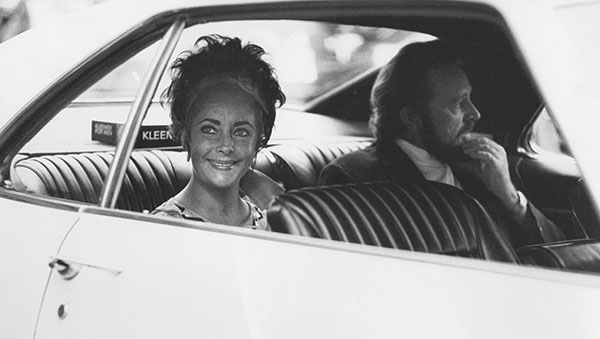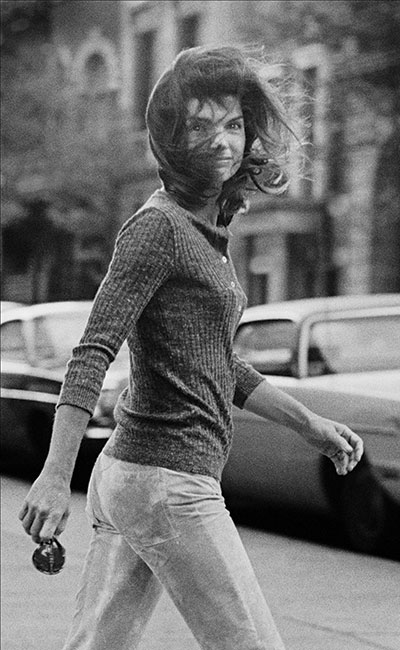
At his home in Montville, legendary lensman Ron Galella demonstrates a favorite tactic. In his day, he says, “A good paparazzo would hide in a car or the bushes and get a candid shot.” He dismisses today’s celeb photographers as “gangbangers” who stand around in packs and harass the rich and famous. Galella’s technique involves not looking through the viewfinder. “I shoot with a wide angle,” he says. “That way I can see the star’s eyes.” Photo by Chris Crisman
The home of Ron Galella, the notorious paparazzo once sued by Jackie Onassis and punched in the face by Marlon Brando, isn’t hard to distinguish from the other houses in his suburban Montville neighborhood.
For starters, Galella’s signature and handprints are impressed on the concrete in front of his Sopranos-style mini-mansion.
The wooden rabbit mailbox and the nearby bunny statue are additional clues. (I’d heard about Galella’s love for rabbits.)
It’s noon when I knock on the front door. After a few minutes, the photographer’s wife, Betty, appears in her bedclothes.
“Sorry for my appearance; we go to bed late around here,” says Betty, who, with her bob haircut, still looks glamorous in her 60s, even in pajamas. She’s charming, too. I could see why Galella asked her to marry him five minutes after they met in 1979. She tells me that Ron is still getting dressed and asks an assistant to show me around the house.
Just inside hangs two rows of large black-and-white prints of some of Galella’s most famous subjects: Paul Newman, Barbra Streisand, Jackie Onassis, Sophia Loren, Princess Diana. Their eyes are tinted blue, which makes the pictures a little unnerving.

Elizabeth Taylor was one of Galella’s favorite subjects. The photographer hid in a London warehouse in 1969 to catch Taylor and fifth husband Richard Burton in their private moments aboard a nearby yacht. This shot of the couple in London was taken in a more traditional paparazzi fashion. Photo by Ron Galella.
As the young assistant, Jeffrey, shows me around the modernly decorated house, I notice that nearly every wall is covered with Galella’s iconic photographs. The list goes on: Robert Redford, Richard Burton, glamorous Elizabeth Taylor, plump Elizabeth Taylor, David Bowie, Steve McQueen. Many are familiar images, but I never knew they were Galella’s. There is even a room dedicated to and inspired by Andy Warhol, adorned with photographs of Warhol. (“Ron was Warhol’s favorite photographer,” Jeffrey tells me.)
Jeffrey leads me to the living room, with its two-story atrium and huge Palladian windows overlooking the garden, where I wait for Galella on the pop-inspired lipstick-red sofa.
Then I look up and I see it: Windblown Jackie. Galella’s most famous photograph.

Galella was in a New York City taxi when he spotted Jacqueline Onassis on Madison Avenue on October 7, 1971. The taxi driver blew his horn and the former first lady turned toward the sound with a half smile, the wind blowing her hair across her face. “I call it my Mona Lisa,” says Galella. Photo by Ron Galella
It’s a 5-foot-high black-and-white print of Jacqueline Onassis that Galella took in 1971, when he was regularly pursuing the former first lady. He got the shot from a New York City taxi, when the driver blew his horn at her and she turned toward the sound with a half smile, the wind blowing her hair across her face.
“I call it my Mona Lisa,” says Galella, who finally appears, dressed in black, his hair silver-grey. At 79, he’s slowed considerably from his days of running after celebrities, wearing disguises, and jumping out of bushes to capture his stunned prey on film. Now, he walks with a limp, the result of knee surgery. But his mind is as sharp as ever. He reconstructs events from the 1970s as if they just happened.
“See that picture?” he asks, pointing to a photo of Mick Jagger giving him the finger from inside a car, with Jerry Hall seated next to him. “He just did that for the camera. He really liked me.”
Galella is charming, too, even with his gruff voice, boxer’s mug, and a street-tough attitude picked up in the Bronx, where he was raised. He still gets excited when he recounts how he got his most famous shots.
Like the time in August 1969 he paid a night watchman $15 to let him into a closed London warehouse for a weekend, where he holed up to secretly take photos of Elizabeth Taylor and Richard Burton—the biggest celebrity couple of the time. Their yacht was docked just below; he was so close, he could hear them arguing over breakfast.
“I only made $400 on those photos,” he remembers. He probably would have made $100,000 or more today.
These days, Galella is semiretired from shooting and spends much of his time working on collections of his photographs—his babies, as he calls them. He has nine books, including his latest, Man in the Mirror: Michael Jackson (Powerhouse Books).
But Galella is about to enter the spotlight again. A film about him, Smash His Camera, will appear on HBO this summer, kicking off the channel’s new documentary series. (The movie is named for Jackie Onassis’s directive to a bodyguard after spotting Galella photographing young John Kennedy Jr.)
The idea to do a Galella documentary first came to producer Adam Schlesinger after he read about a retrospective of the photographer’s work at a New York gallery.
“Celebrities who ran away from him in the past were celebrating his work,” says Schlesinger. “There’s this whole interesting dance that takes place between magazines and celebrities and photographers.”
The film premiered earlier this year at the Sundance Film Festival, and Galella was there, along with Leon Gast, who was named best director of a documentary for the Galella film.
Gast, who also directed the Academy Award-winning film about Muhammad Ali, When We Were Kings, says he was intrigued by the man known as the Paparazzi Superstar.

Galella shot Steve McQueen in April 1973, when McQueen was in Montego Bay, Jamaica, filming the prison flick Papillon. The photographer was hoping to catch McQueen with girlfriend Ali McGraw, who was about to arrive. Instead, the tough-guy actor agreed to give Galella ten minutes—if he would take the next plane off the island. Photo by Ron Galella
“I had an impression of Galella that had been formed way back when he was really infamous, during the Jackie trials, and he was getting a lot of negative publicity,” says Gast. “It seemed like he intruded on a lot of people’s lives.” [The Jackie trials started in 1969. Onassis sued Galella for harassment; he won. In 1972 he sued her for interfering with his livelihood; she countersued for invasion of privacy and harassment. Onassis won, and Galella was ordered to keep 150 feet away from Onassis and her children.]
Once Gast met Galella, he knew he wanted to make the film. “There’s something about him,” says Gast, who grew up in Jersey City. “He’s charming, he’s proud, he’s arrogant and self-centered. Then I realized that these characteristics were very much like somebody else I know—Muhammad Ali. He had that same cocky, egotistical attitude. Both are driven workaholics, conceited, pretentious, with overwhelming opinions of themselves, but generous to individuals. They both have the kind of drive that artists have.”
Galella’s interest in celebrities began in the 1950s, while he was studying photography at art school in Los Angeles on the GI Bill. He wanted to know what movie stars were like in person. He remembers one night crashing a movie premiere and photographing 50 stars, including Lucille Ball and Frank Sinatra.
He had found his calling.
“My Italian teacher in school said, ‘You’re either somebody or a nobody.’ I decided I wanted to be a somebody,” Galella says.
He started to photograph the famous stars of the time, from Elvis Presley to Doris Day to Brando. He missed the opportunity to photograph Marilyn Monroe at her movie studio—he hadn’t yet begun his paparazzo career and was there for other work. He never got another chance to shoot the actress.
Of course, there were other paparazzi in his heyday, but Galella became the best known. He would follow stars all over the world—France, Monte Carlo, Mexico. He feels his work brought a certain amount of respectability to the profession. And many say Galella’s work created paparazzi as we know them today.
But Galella laments the modern-day celebrity photographers, the ones he calls “gangbangers,” who stand in hordes outside restaurants and the homes of celebrities and harass them. “A good paparazzo would hide in a car or the bushes and get a candid shot,” he says.
He says for today’s photographers the work is all about getting glamorous, posed shots of stars or the unflattering, cellulite shots of celebrities on the beach you see in publications such as The National Enquirer.
Galella looked for the spontaneous, unguarded moments—but was not out to make his subjects look bad. In photography school, he’d studied the great photographers, such as France’s Henri Cartier-Bresson (his favorite), and he wanted to emulate them.
“I like to capture stars relating to each other. When they look at the camera, it’s phony, you don’t get the real person,” Galella says. “My technique is, I don’t ask permission. I just start shooting. I’d rather be called names and get the picture I want.”
Like Cartier-Bresson, Galella strove to get the “decisive moment” when photographing stars. And he did get many of those, says Gast.
Given the opportunity to examine Galella’s vast collection of photographs, Gast was amazed at the quality of the work. “I thought, if he’s taken 3.5 million pictures, he has to get lucky—he’ll have ten or twelve great ones,” says Gast. “Then I saw his contact sheets. You can see that this guy is a photographer. The way these pictures are framed, they’re beautiful.
“He had better photos of Elizabeth Taylor than I’ve ever seen. He really got Richard Burton. [Burton] looks like, ‘I want to kill you,’ with that snarl on his face. I would qualify him as a great photographer. I think his work will be remembered 50 years from now, even 100 years from now.”
For now, Galella keeps himself busy with his books and occasionally shooting movie premieres. He says he’s done chasing celebrities. Still, if he had his choice of one of the new young stars to photograph, his choice would be the singer Taylor Swift. “To me, she’s a doll—beautiful, natural. I think she’ll be an icon one day.”
He, of course, already is one.
Galella shot Marlon Brando outside ABC Studios in Manhattan after a taping of The Dick Cavett Show on June 12, 1973. Moments later, Galella asked Brando if he would remove his sunglasses. The actor responded by punching Galella in the face, breaking his jawbone and knocking out five teeth. Galella sued and settled out of court, but eventually made light of the incident, setting up a shot of himself stalking Brando in a football helmet.
Jacqueline Mroz is a frequent contributor.
